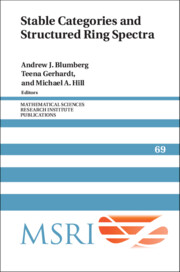Book contents
- Frontmatter
- Contents
- Contributors
- 1 Introduction
- 2 Homotopical categories: from model categories to (∞, 1)-categories
- 3 Stable categories and spectra via model categories
- 4 Stable homotopy theory via ∞-categories
- 5 Operads and operadic algebras in homotopy theory
- 6 Commutative ring spectra
- 7 An introduction to Bousfield localization
- 8 Spectral algebraic geometry
- Bibliography
- Index
5 - Operads and operadic algebras in homotopy theory
Published online by Cambridge University Press: 29 May 2025
- Frontmatter
- Contents
- Contributors
- 1 Introduction
- 2 Homotopical categories: from model categories to (∞, 1)-categories
- 3 Stable categories and spectra via model categories
- 4 Stable homotopy theory via ∞-categories
- 5 Operads and operadic algebras in homotopy theory
- 6 Commutative ring spectra
- 7 An introduction to Bousfield localization
- 8 Spectral algebraic geometry
- Bibliography
- Index
Summary
Operads first appeared in the book Geometry of iterated loop spaces by J. P. May [194], though Boardman and Vogt had earlier implicitly defined a mathematically equivalent notion as a “PROP in standard form” [49, §2]. In those works, operads and operadic algebra structures provide a recognition principle and a delooping machine for n-fold loop spaces and infinite loop spaces. The basic idea is that an operad should encode the operations in some kind of homotopical algebraic structure. For example, an n-fold loop space ΩnX comes with n different multiplications (ΩnX)2 → ΩnX, which can be iterated and generalized to a space of m-ary maps Cn(m) (from (ΩnX)m to ΩnX); here Cn is the Boardman–Vogt little n-cubes operad (see Construction 5.3.5 and Section 5.11 below). The content of the recognition theorem is that Cn specifies a structure that is essentially equivalent to the structure of an n-fold loop space for connected spaces. It was clear even at the time of introduction that operads were a big idea and in the almost 50 years since then, operads have found a wide range of other uses in a variety of areas of mathematics: a quick MathSciNet search for papers since 2015 with “operad” in the title comes up with papers in combinatorics, algebraic geometry, nonassociative algebra, geometric group theory, free probability, mathematical modeling, and physics, as well as in algebraic topology and homological algebra.
Even the topic of operads in algebraic topology is too broad to cover or even summa- rize in a single article. This expository article concentrates on what I view as the basic topics in the homotopy theory of operadic algebras: the definition of operads, the defini- tion of algebras over operads, structural aspects of categories of algebras over operads, model structures on algebra categories, and comparison of algebra categories when changing operad or underlying category. In addition, it includes two applications of the theory: the original application to n-fold loop spaces, and an application to algebraic models of homotopy types (chosen purely on the basis of personal bias). This leaves out a long list of other topics that could also fit in this chapter, such as model structures on operads, Koszul duality, deformation theory and Quillen (co)homology, multiplicative structures in stable homotopy theory (for example, on Thom spectra, K-theory spectra, etc.), Deligne and Kontsevich conjectures, string topology, factorization homology, construction of moduli spaces, and Goodwillie calculus, just to name a few areas.
Information
- Type
- Chapter
- Information
- Stable Categories and Structured Ring Spectra , pp. 183 - 248Publisher: Cambridge University PressPrint publication year: 2022
